Economics
Here’s what to expect from the April jobs report on Friday
Published
2 weeks agoon
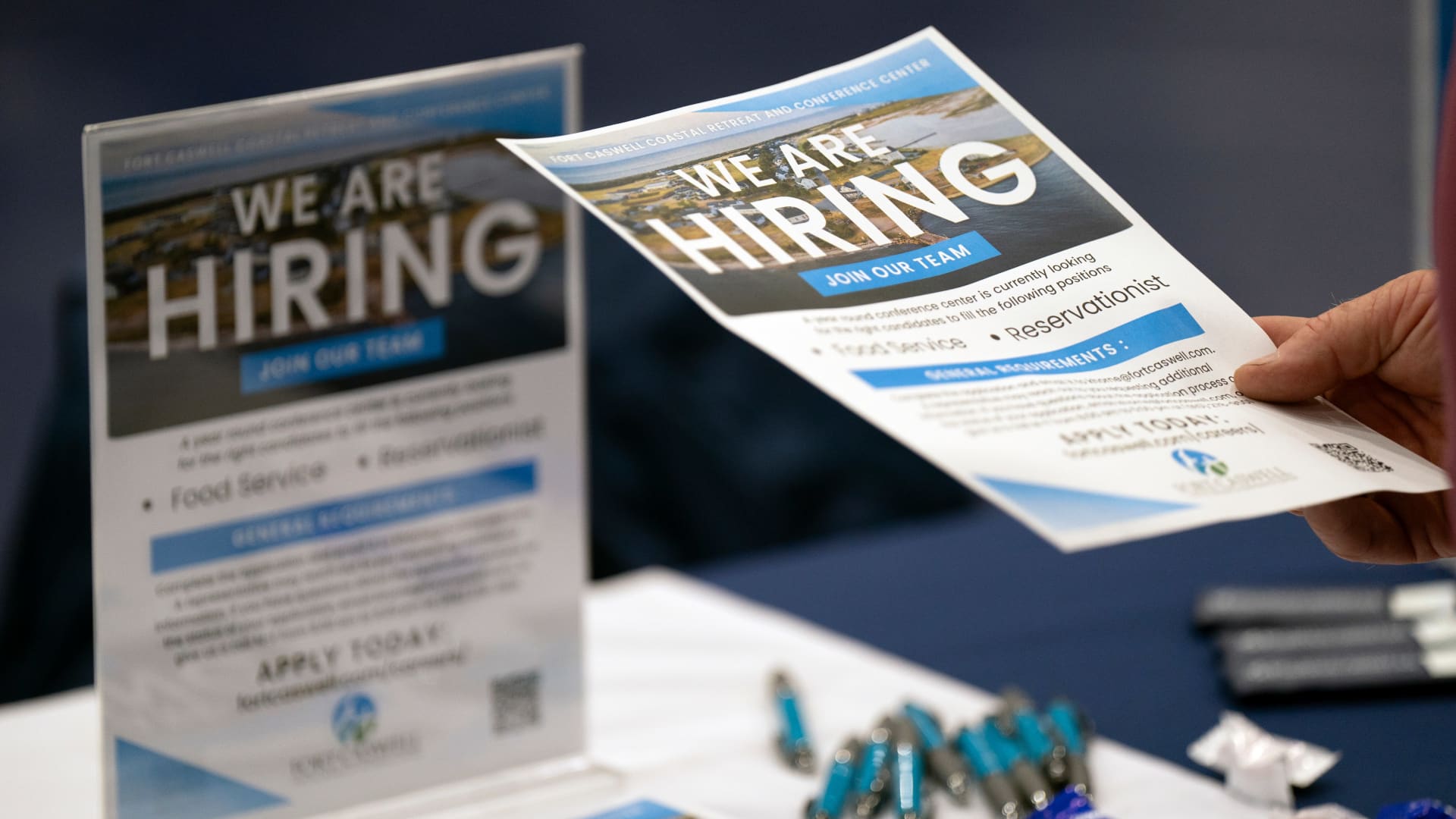
A jobseeker takes a flyer at a job fair at Brunswick Community College in Bolivia, North Carolina, on April 11, 2024.
Allison Joyce | Bloomberg | Getty Images
Hiring likely continued at a brisk pace in April as investors look for any cracks in the labor market that could sway the Federal Reserve.
Nonfarm payrolls are expected to show a gain of 240,000 for the month, according to the Dow Jones consensus that also sees the unemployment rate holding steady at 3.8%.
If that top-line number is accurate, it actually would reflect a small step back from the average 276,000 jobs a month created so far in 2024. In addition, such growth could add to the Fed’s reluctance to lower interest rates, with the labor market humming along and inflation still above the central bank’s 2% target.
“There are definitely still tailwinds left,” said Amy Glaser, senior vice president of business operations at job staffing site Adecco. “For April, the name of the game is steady-Eddie as resiliency continues, and then we’re looking forward to some of the seasonal trends we would expect going into the summer.”
April’s jobs market featured more strength in health care and leisure and hospitality, Glaser added. Those have been two of the major sectors for employment growth this year, with health care adding about 240,000 jobs so far and leisure and hospitality contributing 89,000 jobs.
However, growth in the coming months could spread to areas such as education, manufacturing and warehousing, part of the usual seasonal trends as educators look for alternative employment in the summer and students head out seeking jobs, she said.
“I don’t expect to see major surprises this month based on what I’m seeing on the ground,” Glaser said. “But we’ve been surprised before.”
Beating expectations
Indeed, the labor market has been full of surprises this year, topping Wall Street estimates at a time when many economists expected hiring to have slowed down. The 303,000 gain in March shattered forecasts and were part of a glut of data showing that the labor economy remains strong, wages continue to rise and inflation has not moved much after receding sharply in 2023.
That has pushed the Fed into a box as officials are reluctant to start cutting interest rates until they get more convincing evidence that inflation is under control.
Policymakers will be watching several pieces in tomorrow’s report for evidence that job growth is not helping fuel price pressures.
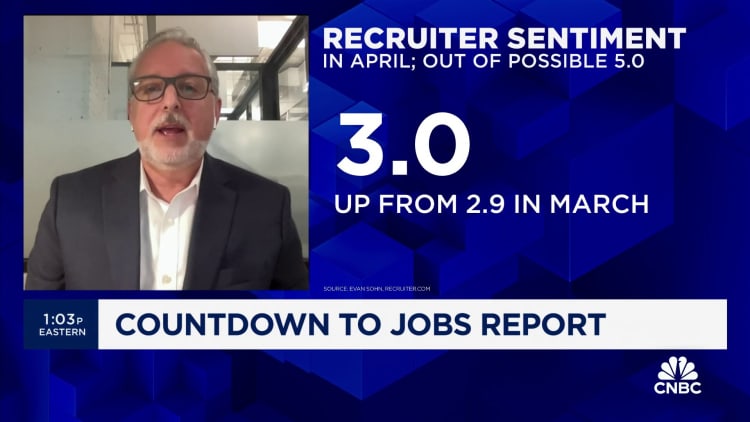
If the payrolls growth misses expectations by a little and wage pressures diminish while more people enter the labor force, that would be an ideal scenario for the Fed, said Drew Matus, chief market strategist at MetLife Investment Management.
“The Goldilocks scenario is an unemployment rate rise with a participation rate rise,” Matus said. “What that’s suggesting is there’s a little bit of weakness that should translate into less wage pressure and take some of the concerns about sustained sticky high levels of inflation off the table.”
Investors on the lookout
Markets also will be watching the wage numbers closely.
Consensus estimates put average hourly earnings growth at 0.3% on the month, near the March move, and the yearly increase at 4%, or just below the 4.1% the month before. However, Matus said the wage numbers could be distorted by immigration patterns as well as California’s minimum wage increase this year to $16 an hour.
Fed Chair Jerome Powell said Wednesday that wage pressures have eased over the past year as the labor market has moved into better balance between supply and demand.
“Inflation has eased substantially over the past year, while the labor market has remained strong, and that’s very good news,” he said at his news conference after the central bank’s latest meeting. “But inflation is still too high.”
Markets have been in a state of flux as uncertainty over the Fed’s rate path has grown, though Wall Street was in rally mode Thursday, the day before the Bureau of Labor Statistics report drops at 8:30 a.m. ET.
“What you’re seeing in markets reflects the uncertainty around the path forward. What’s going to be more important to the Fed, unemployment or inflation?” Matus said. “If unemployment starts moving higher, is the Fed going to care as much about inflation as they do today? Or vice versa? And I don’t think even with all the information the Fed’s given us, that we know. I don’t think anyone knows and I think that’s why you’re seeing the market behave the way it is.”
Don’t miss these exclusives from CNBC PRO
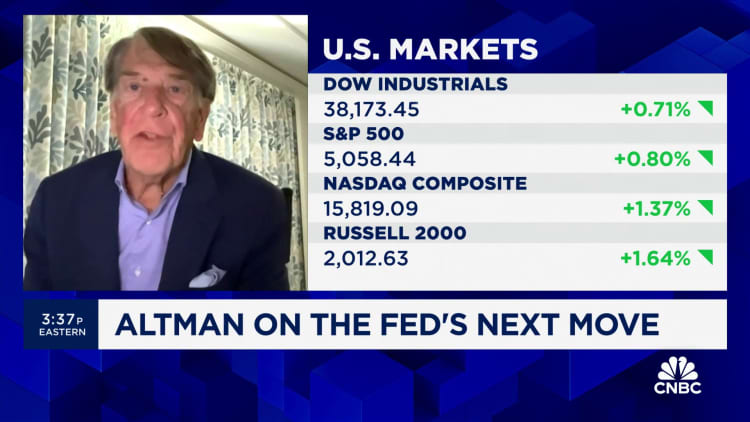
You may like
-
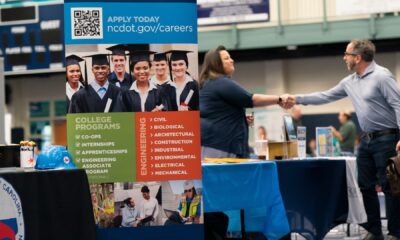

U.S. job growth totaled 175,000 in April
-
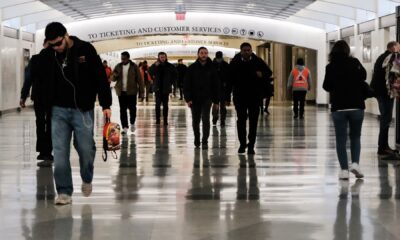

Immigrant workers are helping boost the U.S. labor market
-
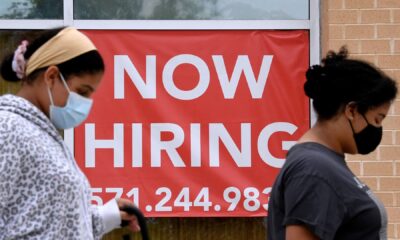

Jobless rates rise in April for all race groups except Black Americans
-


Turkey’s inflation accelerates to nearly 70% in April
-


UK to suffer slowest growth of all rich nations next year, OECD says
-
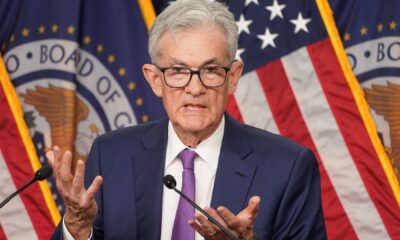

Wall Street is confused and divided over how many times the Fed will cut rates this year

This is the introduction to Checks and Balance, a weekly, subscriber-only newsletter bringing exclusive insight from our correspondents in America.
Sign up for Checks and Balance.
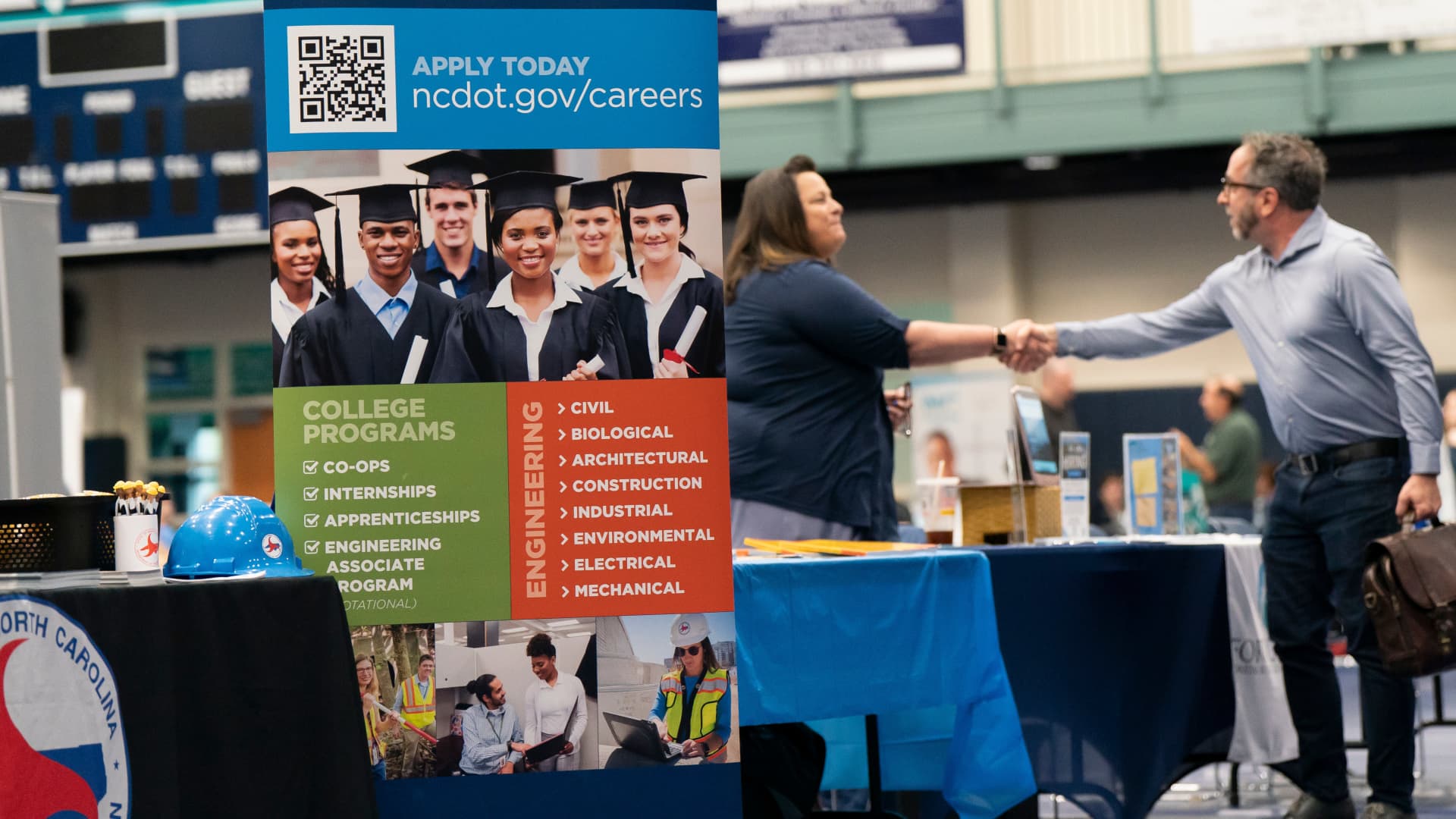
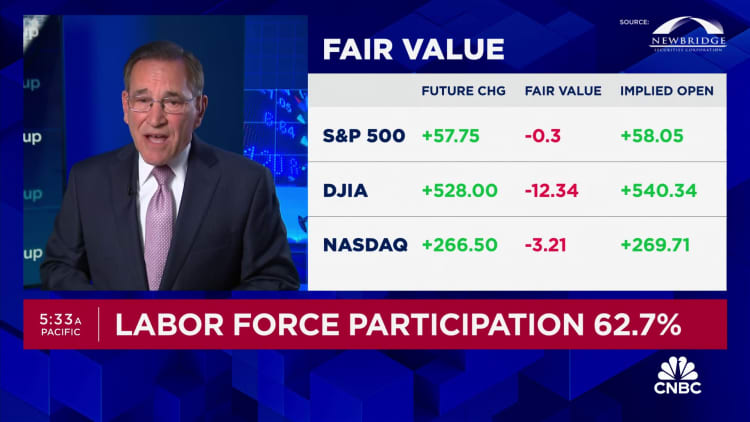
The U.S. economy added fewer jobs than expected in April while the unemployment rate rose, lifting hopes that the Federal Reserve will be able to cut interest rates in the coming months.
Nonfarm payrolls increased by 175,000 on the month, below the 240,000 estimate from the Dow Jones consensus, the Labor Department’s Bureau of Labor Statistics reported Friday. The unemployment rate ticked higher to 3.9% against expectations it would hold steady at 3.8%.
Average hourly earnings rose 0.2% from the previous month and 3.9% from a year ago, both below consensus estimates and an encouraging sign for inflation.
The jobless rate tied for the highest level since January 2022. A more encompassing rate that includes discouraged workers and those holding part-time jobs for economic reasons also edged up, to 7.4%, its highest level since November 2021. The labor force participation rate, or those actively looking for work, was unchanged at 62.7%.
Wall Street already had been poised for a higher open, and futures tied to major stock market averages added to gains following the report. Treasury yields tumbled after being little changed before the release. The report raised the prospect of a “Goldilocks” climate where growth continues but not at such a rapid pace to force the Fed to tighten policy further.
“With this report, the porridge was just about right,” said Dan North, senior economist at Allianz Trade. “What would you like at this point the cycle? We’ve had interest rates jacked up pretty high, so you would expect to see the labor market slow down a little. But we’re still at pretty high levels.”
Consistent with recent trends, health care led job creation, with a 56,000 increase.
Other sectors showing significant rises included social assistance (31,000), transportation and warehousing (22,000), and retail (20,000). Construction added 9,000 positions while government, which had shown solid gains in recent months, was up just 8,000 after averaging 55,000 over the previous 12 months.
Revisions to previous months took the March gain to 315,000, or 12,000 from the initial estimate, and February to 236,000, a decline of 34,000.
Household employment, which is used to calculate the unemployment rate, increased by just 25,000 on the month. Workers holding full-time jobs soared by 949,000 on the month, while those hold part-time jobs slumped by 914,000.
The report comes two days after the Fed again voted to hold borrowing costs steady, keeping its benchmark overnight borrowing rate in a targeted range between 5.25%-5.5%, the highest in more than 20 years.
Following the decision, Chair Jerome Powell characterized the jobs market as “strong” but noted that inflation is “too high” and this year’s economic data has indicated “a lack of further progress” in getting inflation back to the Fed’s 2% target.
But market action shifted after the jobs report indicated an easing labor market and softer wage increases. Traders priced in a strong chance of two interest rate cuts by the end of 2024, with the first reduction expected to come in September, according to CME Group data.
“This is the jobs report the Fed would have scripted,” said Seema Shah, chief global strategist at Principal Asset Management. “The first downside payrolls surprise in several months, as well as the dip in average hourly earnings growth, will bring the rate cutting dialogue back into the market and perhaps explains why Powell was able to be dovish on Wednesday.”
Though inflation has come well off its highs in mid-2022, it is still considerably above the central bank’s comfort zone. Most reports this year have shown inflation around 3% annually; the Fed’s own preferred measure, the core personal consumption expenditures price index, most recently was at 2.8%.
Higher prices have been putting upward pressure on wages, part of an inflation picture that has kept the Fed on the sidelines despite widespread market expectations that the central bank would be cutting interest rates aggressively this year.
Most Fed officials in fact had been mentioning the likelihood of reductions in their public comments. However, Powell at his post-meeting news conference Wednesday made no mention of the likelihood that rates would be lowered at some point this year, as he had in the past.
Don’t miss these exclusives from CNBC PRO
Economics
Immigrant workers are helping boost the U.S. labor market
Published
2 weeks agoon
May 4, 2024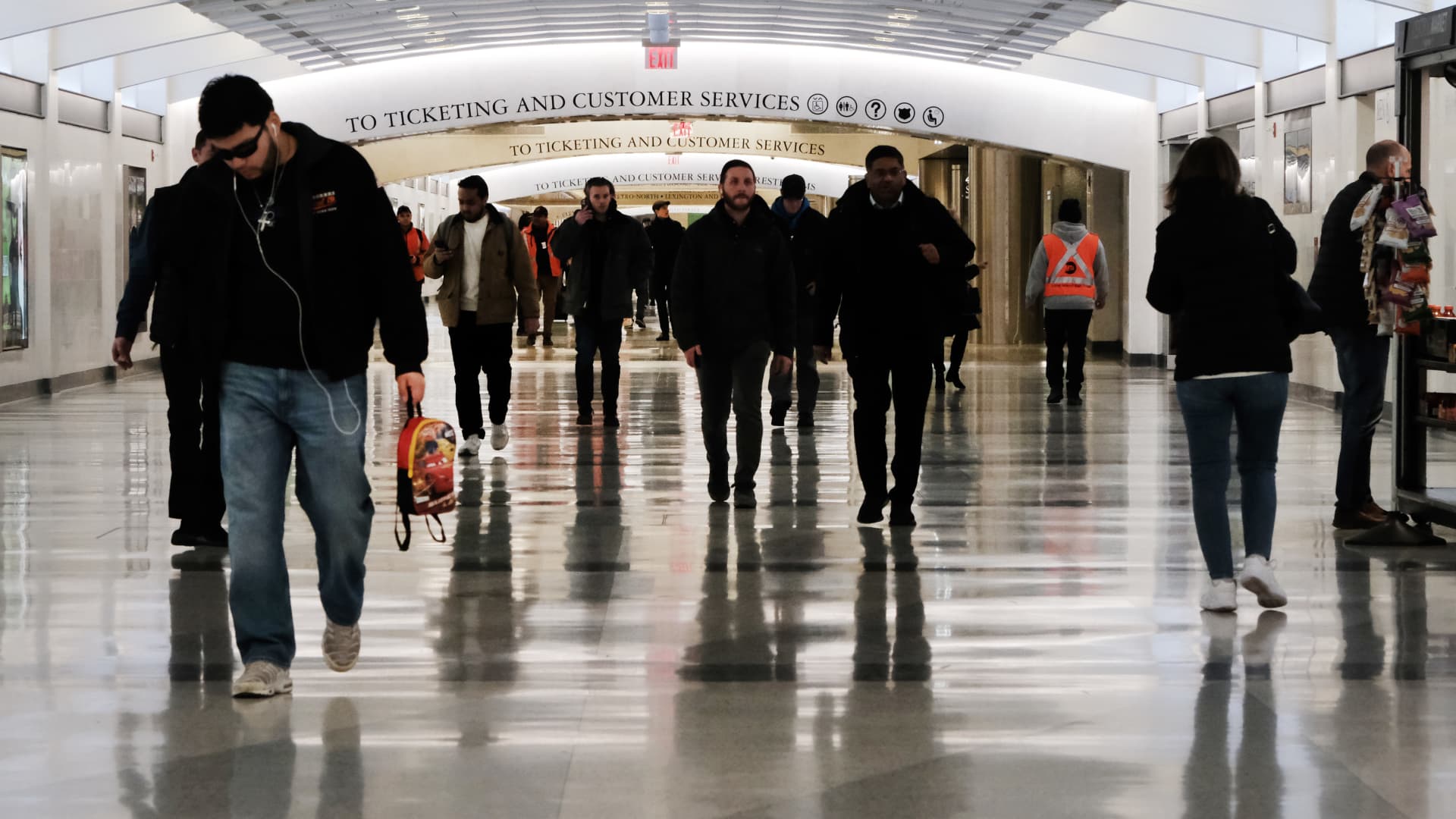
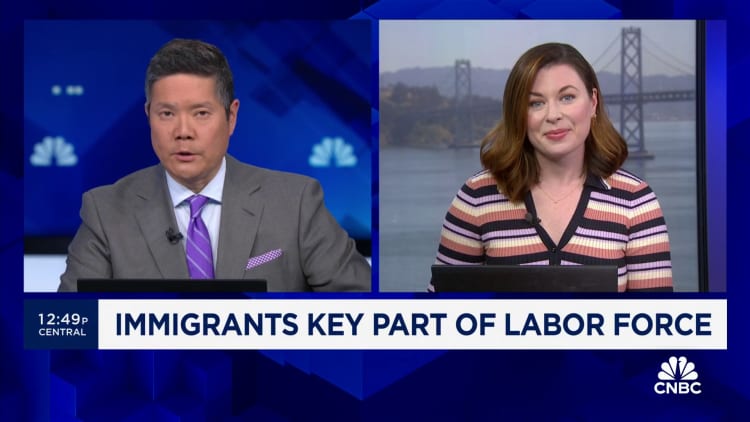
The strong jobs market has been bolstered post-pandemic by strength in the immigrant workforce in America. And as Americans age out of the labor force and birth rates remain low, economists and the Federal Reserve are touting the importance of immigrant workers for overall future economic growth.
Immigrant workers made up 18.6% of the workforce last year, a new record, according to Bureau of Labor Statistics data. Workers are taking open positions in agriculture, technology and health care, fields where labor supply has been a challenge for those looking to hire.
Despite the U.S. adding fewer-than-expected jobs in April, the labor force participation rate for foreign-born workers ticked up slightly, to 66%.
“We don’t have enough workers participating in the labor force and our birth rate has dropped down 2% last year from 2022 to 2023. … These folks are not taking jobs. They are helping to bolster and helping us build back — they’re adding needed workers to the labor force,” said Jennie Murray, CEO of the National Immigration Forum, a nonpartisan nonprofit advocacy organization.
The influx of immigrant workers is also a projected boost to U.S. output, and is expected to grow gross domestic product over the next decade by $7 trillion, Congressional Budget Office Director Phillip Swagel noted in a February statement accompanying the 2024-2034 CBO outlook.
“The labor force in 2033 is larger by 5.2 million people, mostly because of higher net immigration. As a result of those changes in the labor force, we estimate that, from 2023 to 2034, GDP will be greater by about $7 trillion and revenues will be greater by about $1 trillion than they would have been otherwise. We are continuing to assess the implications of immigration for revenues and spending,” Swagel wrote.
‘Huge competition’
Goodwin Living, a nonprofit faith-based elder-care facility in Northern Virginia that cares for 2,500 adults day to day, is heavily reliant on immigrant workers. Some 40% of its 1,200 workers are foreign-born, representing 65 countries, according to CEO Rob Liebreich, and more workers will be needed to fill increasing gaps as Americans age and need assistance.
“About 70% of 65-year-olds are expected to need long-term care in the future. We need a lot of hands to support those needs,” Liebreich told CNBC. “Right now, one of the best ways that we see to find that is through people coming from other countries, our global talent, and there’s a huge competition for them.”
In 2018, Goodwin launched a citizenship program, which provides financial resources, mentorship and tutoring for workers looking to obtain U.S. citizenship. So far, 160 workers and 25 of their family members have either obtained citizenship or are in the process of doing so through Goodwin.
Wilner Vialer, 35, began working at Goodwin four years ago and serves as an environmental services team lead, setting up and cleaning rooms. Vialer, who came to the U.S. 13 years ago from Haiti, lost his job during the pandemic and was given an opportunity at Goodwin because his mother had been employed at the facility.
He applied for U.S. citizenship before getting his current job, but after he worked there for six months, the Goodwin Living Foundation covered his application fee of $725, the nonprofit said. Vialer became a U.S. citizen in 2021, and his 15-year-old daughter received a citizenship grant and became a U.S. citizen in 2023.
Vialer’s hope is to have his wife join the family from Haiti, as they have been separated for six years.
“This program is a good opportunity,” Vialer said. “They help me, I have a family back home. … This job really [does] support me when I get my paycheck to help them back home.”
Workers are not required to stay with Goodwin after becoming U.S. citizens, but those who do stay are there 20% longer than those who do not participate in the program, Liebreich said. Speeding up the path to citizenship is key to remaining competitive in a global economy, he added.
“If we want to attract and retain this global workforce, which we desperately need, we need to make the process a lot easier,” Liebreich said.
Looking ahead to November, immigration will be a hot topic on the presidential campaign trail and for voters. Both President Joe Biden and former President Donald Trump have made trips to the southern border in recent months to address the large number of migrants entering the country.

Betting on the Kentucky Derby? Here’s how to think like a professional handicapper.

Warren Buffett says Greg Abel will make Berkshire Hathaway investing decisions when he’s gone

EV makers win 2-year extension to qualify for tax credits

Are American progressives making themselves sad?

‘Best Firms for Tech’ 2024 deadline extended to April 10

